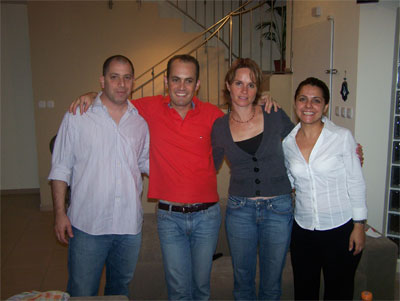Here is the Stanley Ruby obituary from Hyperfine Interactions, as downloaded from the Springer-Verlag library of scholarly journals. Thank you to Gopal Shenoy for making this happen and keeping us informed. It is wonderful to have this assessment by three of Stan's peers of his impact in the physics world.


OBITUARY
Stanley Ruby 1924–2004
Gopal Shenoy & Gennadii Smirnov & John Arthur
© Springer Science + Business Media B.V. 2006
Hyperfine Interact
DOI 10.1007/s10751-006-9348-8
Stanley L. Ruby, who made major contributions to Mössbauer spectroscopy and who inspired the community with the idea of observing the Mössbauer effect using synchrotron radiation, passed away on October 18, 2004, in Los Gatos, California. His boundless intellectual curiosity and passion for life was an inspiration to all around him, especially his scientific colleagues.
Born in New York City in 1924, Stan served in the US Army Signal Corps during World War II in New Guinea and the Philippines. He performed his undergraduate and graduate studies at Columbia University, guided in his graduate work primarily by Professor Madame C.-S. Wu.
He briefly worked at the IBM Watson Laboratory before starting his work on Mössbauer spectroscopy with Fe57 in 1960 at Westinghouse Electric Corporation. He collaborated with Paul Flinn (Stanford University) and Gen Shirane (Brookhaven National Laboratory), studying a large class of magnetic compounds. His most recognized work from this period was on the acoustic modulation of the wavelength of resonant gamma radiation, detected using the Mössbauer effect. During a visit to the Weizmann Institute in 1962, he observed the 9.3 keV Mössbauer resonance in Kr83.
Stan joined Argonne National Laboratory in 1964, where he was involved in the discovery of many Mössbauer resonances, including K40. Since this isotope has no radioactive parent, Stan and R. E. Holland (Argonne) observed it by populating the 29.4 keV excited nuclear state by means of deuteron bombardment (K39(d,p)K40). Later, Stan and D. H. Vincent (University of Michigan) excited the K40 resonance through the neutron capture reaction (K39(n, +)K40).
Argonne provided an ideal setting for Stan. He could incubate his ideas with colleagues who helped them blossom into successful experiments. He actively worked with a large number of scientists from different divisions at Argonne, with backgrounds in nuclear physics, materials science, and solid state physics. This was essential for establishing new Mössbauer resonances and finding the best techniques to unravel nuclear, chemical and solid state properties. In particular, his collaboration with Michael Kalvius, Bobby Dunlap and Gopal Shenoy led to many publications dealing with resonances in Sn119, Sb121, Te125, I127,129, U238, Np237, Am243.
Stan will be best remembered for his proposal in 1974 to excite the 14.4 keV Mössbauer resonance in Fe57 using synchrotron radiation rather than a radioactive source to populate the nuclear excited state. Stan struggled for years to develop techniques for separating the nuclear resonant X-rays from the overwhelming background. In the early 1980s, Stan moved from Argonne to the Stanford Synchrotron Radiation Laboratory with the sole desire to succeed with his idea. Although it was the group of Erich Gerdau that first achieved this goal in 1985 at DESY, Stan and the SSRL group followed in 1987 and proceeded to make important contributions to this new field.
During the period 1990–1995 Stan and the Stanford group collaborated closely with scientists from Russia (Kurchatov Institute) and Germany (Munich Technical University) in a series of experiments at SSRL and CHESS. They observed and explained several surprising features of the coherent nuclear exciton created by a synchrotron pulse in a nuclear sample, such as the extreme speed-up of the nuclear exciton decay in scattering from a multilayer, and the nuclear exciton echo induced by vibrating a portion of an excited sample. They were also the first to use synchrotron radiation to excite the narrow 6.2 keV Mössbauer resonance in Ta181. Stan was particularly concerned with the conceptual problem of understanding “when and where” the interaction of X-ray photons with nuclei occurs during the propagation of radiation pulses through a target.
Fundamental physics was central to Stan’s life, though his interests ranged from cosmology to biology. While he allowed that quantum mechanics was useful for calculations, he found it very unsatisfactory on a philosophical level. During his later career, and especially after his retirement, he worked hard to find simple, alternative explanations for quantum phenomena. Stan was young in soul, always individualistic and passionate about his scientific ideas, which sometimes touched very exotic fields. His mind was most acute when he was talking, so he was eager to sit and talk about his latest ideas.
These discussions were always interesting, involving physics, history, astronomy, and politics. Stan’s lifelong concern with the impact of science on society was expressed in his leading role in the campaign against anti-ballistic missiles during the 1970s. Beyond his consuming interest in physical science, his many pursuits included international travel, outdoor recreation, marine life, and observing the human parade.
He was truly a family man and took an avid interest in the lives of all his colleagues. He is survived by his wife of 57 years, three children, and four grandchildren. His friends on several continents will miss him. We remember Stan for his never-fading enthusiasm to discuss physics with anyone who would listen, his friendship, and above all his curiosity for new ideas.
G. Shenoy (*)
Argonne National Laboratory, Argonne, IL, USA
e-mail: gks@aps.anl.gov
G. Smirnov
Russian Research Center “Kurchatov Institute”, Moscow, Russia
J. Arthur
Stanford Linear Accelerator Center, Stanford, CA, USA



